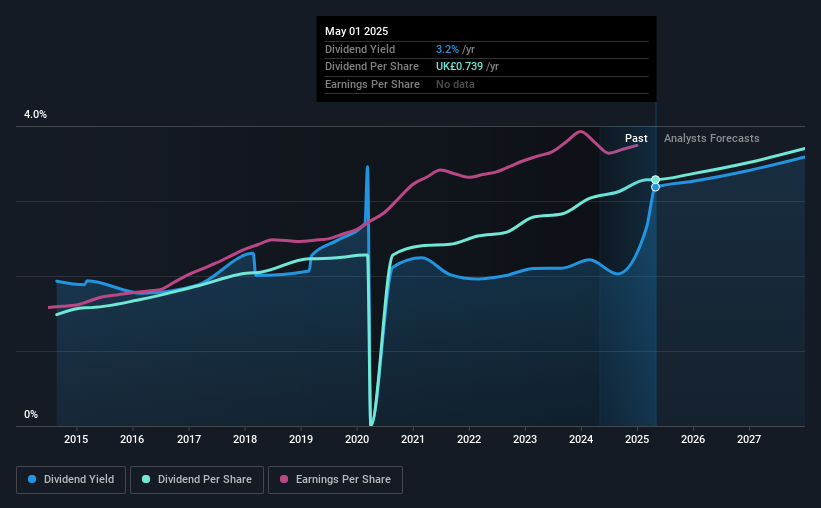- United Kingdom
- /
- Trade Distributors
- /
- LSE:BNZL
Bunzl's (LON:BNZL) Shareholders Will Receive A Bigger Dividend Than Last Year

Bunzl plc (LON:BNZL) will increase its dividend from last year's comparable payment on the 2nd of July to £0.538. This will take the annual payment to 3.2% of the stock price, which is above what most companies in the industry pay.
While the dividend yield is important for income investors, it is also important to consider any large share price moves, as this will generally outweigh any gains from distributions. Bunzl's stock price has reduced by 33% in the last 3 months, which is not ideal for investors and can explain a sharp increase in the dividend yield.
Bunzl's Payment Could Potentially Have Solid Earnings Coverage
Impressive dividend yields are good, but this doesn't matter much if the payments can't be sustained. The last dividend was quite easily covered by Bunzl's earnings. This means that a large portion of its earnings are being retained to grow the business.
The next year is set to see EPS grow by 14.8%. Assuming the dividend continues along recent trends, we think the payout ratio could be 45% by next year, which is in a pretty sustainable range.

View our latest analysis for Bunzl
Dividend Volatility
While the company has been paying a dividend for a long time, it has cut the dividend at least once in the last 10 years. Since 2015, the annual payment back then was £0.334, compared to the most recent full-year payment of £0.739. This works out to be a compound annual growth rate (CAGR) of approximately 8.3% a year over that time. We have seen cuts in the past, so while the growth looks promising we would be a little bit cautious about its track record.
Bunzl Could Grow Its Dividend
Given that the dividend has been cut in the past, we need to check if earnings are growing and if that might lead to stronger dividends in the future. We are encouraged to see that Bunzl has grown earnings per share at 8.0% per year over the past five years. Shareholders are getting plenty of the earnings returned to them, which combined with strong growth makes this quite appealing.
Our Thoughts On Bunzl's Dividend
Overall, this is a reasonable dividend, and it being raised is an added bonus. The dividend has been at reasonable levels historically, but that hasn't translated into a consistent payment. The payment isn't stellar, but it could make a decent addition to a dividend portfolio.
Companies possessing a stable dividend policy will likely enjoy greater investor interest than those suffering from a more inconsistent approach. At the same time, there are other factors our readers should be conscious of before pouring capital into a stock. As an example, we've identified 3 warning signs for Bunzl that you should be aware of before investing. If you are a dividend investor, you might also want to look at our curated list of high yield dividend stocks.
Valuation is complex, but we're here to simplify it.
Discover if Bunzl might be undervalued or overvalued with our detailed analysis, featuring fair value estimates, potential risks, dividends, insider trades, and its financial condition.
Access Free AnalysisHave feedback on this article? Concerned about the content? Get in touch with us directly. Alternatively, email editorial-team (at) simplywallst.com.
This article by Simply Wall St is general in nature. We provide commentary based on historical data and analyst forecasts only using an unbiased methodology and our articles are not intended to be financial advice. It does not constitute a recommendation to buy or sell any stock, and does not take account of your objectives, or your financial situation. We aim to bring you long-term focused analysis driven by fundamental data. Note that our analysis may not factor in the latest price-sensitive company announcements or qualitative material. Simply Wall St has no position in any stocks mentioned.
About LSE:BNZL
Bunzl
Operates as a distribution and services company in the North America, Continental Europe, the United Kingdom, Ireland, and internationally.
Undervalued with adequate balance sheet and pays a dividend.
Similar Companies
Market Insights
Community Narratives



